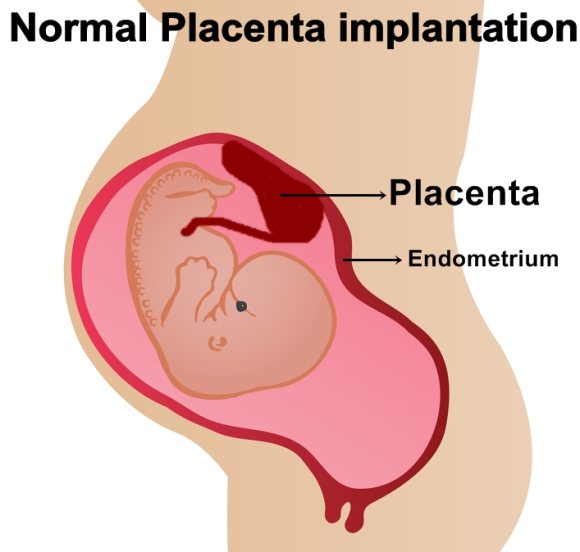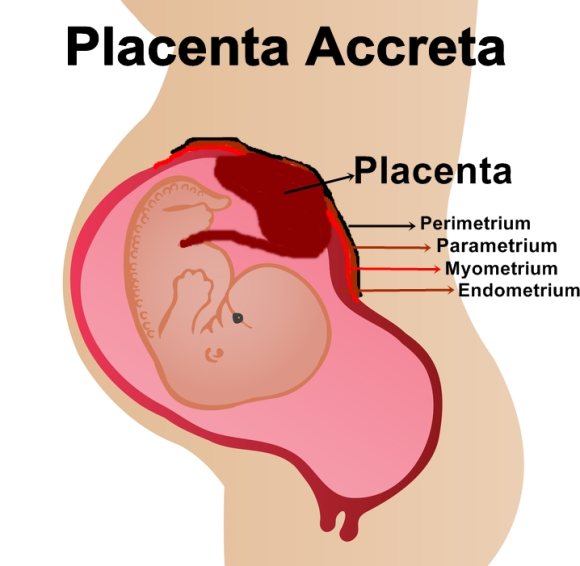Several women who get pregnant do not give the placenta a second thought. Most people do not even know what the placenta is and what a huge role it plays in the smooth progress of a pregnancy. When the placenta is not in good condition or is located at an unusual location in the uterus, it can cause problems. Pregnancy complications involving the placenta can be life-threatening to both mother and baby. Placenta accreta is one such issue with the location of the placenta that is known to create a hazardous situation.
What is Placenta Accreta?
 During pregnancy, the placenta is attached to the lining of the uterus (Endometrium) where it stays until the baby is delivered. After your baby is born, you will experience uterine contractions that are designed to expel the placenta, which is no longer needed in your body. In fact, if even a small piece of the placenta remains in your uterus after delivery it can cause problems like a uterine infection or hemorrhage.
During pregnancy, the placenta is attached to the lining of the uterus (Endometrium) where it stays until the baby is delivered. After your baby is born, you will experience uterine contractions that are designed to expel the placenta, which is no longer needed in your body. In fact, if even a small piece of the placenta remains in your uterus after delivery it can cause problems like a uterine infection or hemorrhage.
With placenta accreta, the placenta is attached not on the wall of the uterus, but deeply in it. It can sometimes go all the way through the uterine wall and attach itself to a nearby organ as well. A placenta that is so deeply attached in the uterine wall is not easily expelled after the baby is born. Manual intervention is necessary, and in most cases, surgery. There are several risks to both mother and baby in such a case.
 To understand the depth to which the placenta can embed itself, it is first important to know a little more about the uterus. The uterus is made up of four layers:
To understand the depth to which the placenta can embed itself, it is first important to know a little more about the uterus. The uterus is made up of four layers:
– The endometrium or the innermost layer – the lining of the uterine wall
– The myometrium comes next; this is the muscle layer of the uterus
– then there is the layer of connective tissue around the uterus called the parametrium
– and lastly, there is the perimetrium which is the outermost layer
In a normal pregnancy, the placenta attaches itself to the endometrium. In cases of placenta accreta, the placenta attaches itself to the deeper layers of the uterus. There are three kinds of placenta accreta based on the depth of the placental attachment.
- Placenta accreta is when the placenta attaches itself along the lining of the myometrium. It is very difficult for the placenta to detach in this condition.
- Placenta increta is when the placenta will invade even deeper into the muscle in the myometrium. A worrisome situation as it may warrant the removal of the uterus.
- Placenta percreta is when the placenta goes beyond the myometrium and attaches itself to the parametrium, the perimetrium, or even the organs beyond the uterus like the rectum or the bladder. This is the most dangerous variant of all as it can destroy the organ and necessitate a hysterectomy (removal of the uterus).
Long-term studies have revealed that the incidence of placenta accreta is higher today than it was less than one hundred years ago. Doctors feel that this is because of the increase in the number of women opting to deliver their babies via C-section rather than vaginal delivery. Out of every 2,500 women, one will have placenta accreta. A far cry from 70 years ago when it was 1 in 30,000.
Out of the all the women who develop placenta accreta, 75% will develop the first variant i.e. the palcenta will attach itself to the outer lining of the myometrium, 15% will have placenta increta and 10% will have placenta percreta.
Pregnancy Complications of Placenta Accreta
- Placenta acccreta may cause premature birth. Babies who are born prematurely may not be developed fully as they have not had enough time in the womb to do so. Premature birth can thus bring on its own set of problems for the baby like difficulty breathing, impaired neurological development, loss of vision, low birth weight, and death, to name just a few.
- After you give birth, your uterus continues to have contractions to expel the placenta. The contractions also help to stem the flow of bleeding which is normal with delivery. However, placenta accreta can hamper the contractions of the uterus and the bleeding may be excessive. This kind of hemorrhaging can lead to shock and even death if unchecked.
- Sometimes, the only way to stop the bleeding is by conducting an emergency hysterectomy or removal of the uterus. This means that you can never conceive again.
- More than half of the women who have placenta accreta will need a blood transfusion.
Causes and Risk Factors of Placenta Accreta
No one knows why placenta accreta occurs. But some factors that increase your risk of having placenta accreta have been identified.
- Uterine scarring from a C-section or surgery on the uterus increases your risk for placenta accreta. For reasons unknown, the placenta is more likely to develop exactly on the scar of a past surgery and allows it to infiltrate deeper into the uterine wall. This increases the risk of placental pregnancy complications like placenta accreta.
- Studies have shown that your risk of placenta accreta is much higher if you also have placenta previa. 10% of all placenta previa cases will be further complicated by placenta accreta. As a matter of fact, placenta accreta is a rare occurrence in women who do not have palcenta previa.
- The age of the mother is another risk factor for placenta accreta. Women over 35 are more likely to develop the condition.
- Women who have had multiple pregnancies are at an increased risk of placenta accreta.
Symptoms of Placenta Accreta
There are rarely any symptoms of placenta accreta. Most women do not even know they have placenta accreta till after they have given birth and the placenta has not been expelled. Placenta accreta does not always show up on an ultrasound. However, some women who have had placenta accreta experienced vaginal bleeding during the pregnancy second trimester or pregnancy third trimester, although this is not an exclusive symptom of the condition.
Diagnosis and Treatment of Placenta Accreta
Placenta accreta is rarely diagnosed before delivery. It is only in rare cases that symptoms occur that lead doctors to suspect placenta accreta. But generally, the diagnosis will be made once you are on the delivery table and the placenta does not pass through like it is supposed to within 30 minutes of your baby being born. At such a time, you and your doctor will have to make an emergency decision about what to do based on how severe your case is and if you want to have children in the future. If you are at high risk for placenta accreta, your doctor may be able to diagnose it after a vaginal ultrasound. She will then recommend bed rest, medication to speed up the development of your baby’s lungs, and a C-section as soon as possible before pregnancy complications of palcenta accreta start to surface.
There is no way to treat placenta accreta. This means that once you have it, the condition can in no way be reversed. Since placenta accreta is mostly asymptomatic, the decisions about what to do when it is diagnosed will be spur of the moment.
- If you are bleeding heavily and your doctor knows you do not want any more children, she may advise a hysterectomy to remove your uterus. This is the most widely accepted option and the safest solution to the problem.
- If you are bleeding heavily and are planning to conceive again, your doctor may attempt to surgically cut out the placenta. This could lead to a great loss of blood. And the required surgical procedure could take hours. Other factors like your general health will have to be taken into account when choosing this option.
- If you are stable and greatly desire more children, you do have the option to just leave the pieces of the placenta that cannot be taken out in the uterus. This has been done in a few cases with no dire consequences. But be warned that it puts you at a very high risk for a uterine infection and bleeding.
Prevention of Placenta Accreta
Unfortunately, there is absolutely nothing you can do to prevent placenta accreta. You could perhaps reduce your risk of developing placenta accreta and other placental pregnancy complications by opting for vaginal childbirth instead of a C-section. Since this will also reduce your risk for placenta previa, another risk factor for placenta accreta, it may do the trick. In fact, if you have placenta previa, your doctor will prepare you for the pregnancy complications of placenta accreta as well. So it would be in your best interests to look up the risk factors for placenta previa and see if any of them are within your control.
Also ensure that you are regular with your doctor’s appointments throughout your pregnancy. If placenta accreta is somehow detected early on, you will at least have a chance to learn more about it, discuss with your doctor what should be done in all possible scenarios, and mentally prepare your self for the coming ordeal.
Image: Shutterstock
